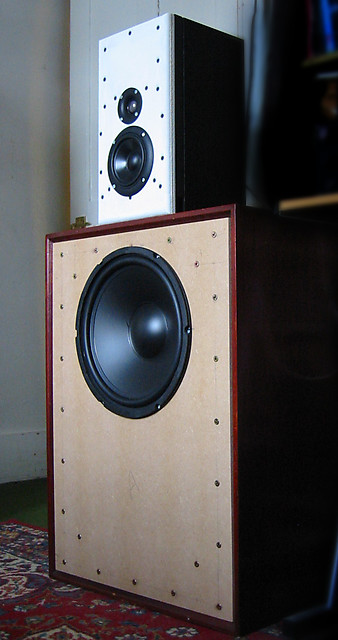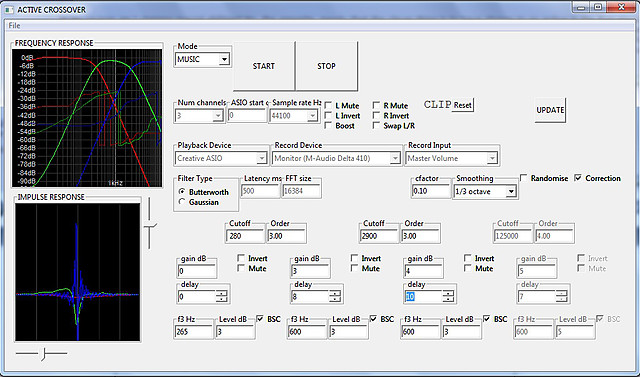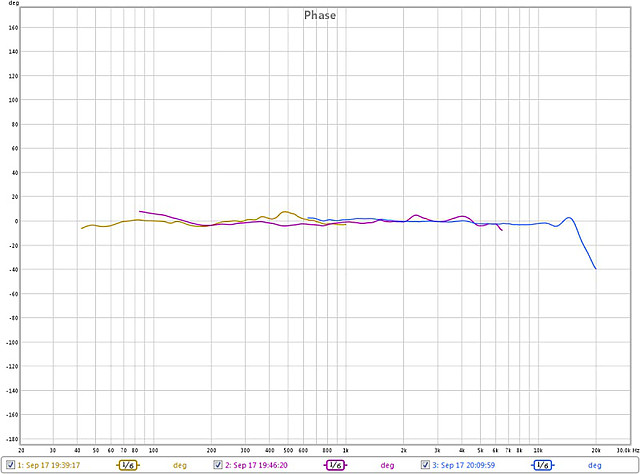The Rational Audio System
What price high-fidelity? I wouldn’t be the first to question the price of high-end audio equipment and what seems increasingly to be a disconnect between asking prices and the reasonable means of most music-lovers. Reading the online reports from audiophile shows, it is not uncommon these days to see systems – nay, individual components – costing as much as a new car.
Don’t get me wrong – it’s not that I think that superb audio reproduction wouldn’t necessarily be worth that kind of money. What bothers me is that, despite having received a windfall of DSP power and technically excellent audio hardware off the back of the computer industry, the hifi industry hasn’t really taken advantage of it to drive towards what is theoretically correct or optimal.
What do I mean by “theoretically correct or optimal”? Simple: flat frequency response, low distortion, and linear phase (i.e. no time distortion). It seems, though, that the high-end audio industry prefers to operate on received wisdom instead – that is, the way we did it before. I refer to valves, vinyl, passive crossovers, ported boxes. Instead of using current technology to address fundamental issues, much of the high-end audio industry seems to want to simply dress up traditional compromises with exotic materials and pointless over-engineering.
A Rational Approach
Were the traditional audio technologies developed by very clever people who deliberately wanted to distort the signal for a better listening experience? Well, no, of course not. The history of audio development for much of the last century was one of striving to reach the goal of perfect linearity, with only the inherent limitations of the technology getting in the way. Naturally, as new innovations were made, older technologies were generally abandoned by the industry in favour of more inherently accurate methods.
I have become convinced that we now live in an age where it should be possible to reproduce a signal accurately in the frequency and time domains, yet at reasonable cost. A rational set of design goals would be:
- Basic linearity. Many high-end systems seem to disregard this aspect, or it is branded as ‘un-musical’.
- Bass response. Systems should have bass that goes all the way down.
- Time domain accuracy. Regardless of cost, very few systems actually provide this.
In other words, my argument is that we should simply ditch every arbitrary distortion of the signal if we can. Is there a sensible argument that says we should not do this? By steadfastly obeying common sense and refusing to be swayed by romantic notions, I think that a genuinely great system could be built from generic components for a few hundred pounds – not the price of a Bentley. While more expensive drivers and more elaborate construction techniques would make the system better, it is the basic “topology” that is the key to high performance.
Testing the concept
Unfortunately, I don’t think the truly rational system is commercially available. I realised some time ago that If I wanted to experience it for myself, it could only be through building it and trying it. So, as a person who knew a bit about software and hardware, but had never built a pair of speakers before, I thought I’d have a go. Here’s what I came up with:
- Two very large sealed enclosures, each containing a 12-inch woofer on a moderately wide baffle.
- A smaller midrange/tweeter enclosure with a 4-inch mid and a small tweeter set very close to the mid.
- A PC running my own DSP code, which does linear-phase crossover filtering and other processing.
- Three inexpensive power amplifiers and assorted cables to hook it all up.

They don’t win any prizes for beauty, but they work pretty well…
This is, of course, an active system. By having each driver connected directly to the amplifier terminals (with the exception of the tweeters that do have a series protection capacitor), the demands on the amplifiers are reduced and driver performance is improved – see 8 Advantages of Active Crossovers by Douglas Self. It’s important to understand, however, that the fact that the system is active is only part of the “rational story.” Most active crossovers – as with most passive crossovers – introduce a phase shift across the frequency band. In the time domain, the system is therefore unable to produce a waveform that looks anything like what went in. Ensuring that the phase relationships are correct across the audio band is the only solution – if, that is, you want time domain accuracy.
The tight spacing of the drivers and the choice of driver sizes provides a reasonably well-controlled off-axis response (although this was not the primary goal of the project). Because the enclosures are sealed, the woofer cones are still controlled by the amp below resonance, and the bass roll-off with no extra EQ is 12 dB per octave. The -3 dB point is at about 35 Hz. My listening room is an average size and the bass is supplemented by some “room gain” – see this link for how that works.
The heart of the system is the software that provides driver correction based on measurements, linear-phase crossover filtering, and time delays, to ensure that all three drivers deliver an impulse at the listener’s ears at the same moment. It accepts any PC audio source (CD, streaming, etc.) and processes it in real time. I haven’t tried any source format other than ‘CD resolution’ (16-bit, 44.1 kHz) but the system could be set up to use other sample rates and bit depths. Internal calculations are performed in floating point and the output is sent to the DACs (in the sound card) as 24-bit.

Prototype PC application provides real time crossover filtering and driver correction
A not-very-beautiful graphical user interface (GUI) allows adjustment of all parameters (e.g. crossover slopes) in real time. There is no attempt at room correction as such. I spent quite a while refining the software, adding useful features, and homing in on what I thought was the best setup. The current setup uses FIR filters similar to Butterworth, at 275Hz and 2500Hz, both of order 3.5. The driver corrections are smoothed phase only, based on near field measurements, and these are combined with the crossover filters.

Near field phase response of the three drivers after the crossover/correction filters
In summary, the key features of this topology: no frequency-dependent phase shift, no drivers wired backwards to match the phase through the crossover, no unnecessary arbitrary delays of one frequency band relative to any other, no loss of stereo image as the two channels distort. The amplifiers are barely stressed, driving an easy load without wasting power in passive components, and any amplifier distortion (now unlikely) affects only a single driver, not contaminating all three. Direct connection to the amplifier means excellent damping and control of each cone. The absence of bass resonators (e.g. ports) means the bass is precise and controlled, and even though the woofers go very low before rolling off, the response rolls off gently rather than disappearing quickly. The phase correction serves to ‘tighten up’ the bass even further.
Perhaps each of these individual desirable attributes is relatively minor. But put them all together, and I assure you that the result is… phenomenal. I’d go as far as to say that it is startlingly good, way better than anything I have owned or even heard in my years of being an audiophile. I am not tooting my own horn here – this is I believe just the consequence of taking the rational approach described above. There are real, objective, measurable reasons why the sound might be different from any other system you’ve heard. Reviews of high-end commercial DSP-based active systems describe the amazing clarity, image and focus while at the same time the speakers are “caressing” the ears. That is the phase correction at work; once you’ve heard it, you can’t go back…
These are the first speakers I have ever built. Despite the low cost of the components I used, I am still astounded by it a year on and haven’t felt the need to change anything substantial in that time. I spent about £380 (~USD580) on the parts, in addition to using items I had lying around already. And, of course, used my own free time to build the speakers and code up the software. Still, as a novice speaker constructor (but nevertheless experienced hifi enthusiast), I could not possibly have expected to produce anything like this using conventional means.
Concluding remarks
Despite all of the ‘dots’ being in place, few have joined them together to produce the entirely rational, low-cost audio system. It isn’t hard or expensive to do, but it does require skills in a variety of disciplines all working together. My version isn’t necessarily suitable for every living room but I think dedicated audiophiles would be amazed at the sound, and the cost would be far lower than they are used to. Ironically, one of the very simplest systems for a DIY-er to design and construct could also turn out to be one of the best-performing regardless of price.
[Editor’s note: Richard continues to explore the concept of the rational audio system on his blog: The Rational Audiophile.]




Dear Sir: thank you for a “rational” DIY piece. Your carpentry skills far exceed mine, as do your programming skills. It is on this last point I would like to add my comments. Your overall goals are excellent (to make the best, most tweakable system for the least cost). However, very few people will have the know-how to code their own DSP. Even for old folks like me who may have a CompSci degree but never coded anything harder than a small BAT file or a Unix shell script, may I suggest hobbyist-friendly no-programming-required DSP solutions? MiniDSP is one I’ve used (learned of it on this web site in fact) and very flexible. There is also Sigma Studio and no doubt others. One point your article makes and I’m probably paraphrasing: the tools (cheap hardware and software) exist for the hobbyist to create a unique system, but it does require learning a bit about the tools. After all, the hacking, tweaking, adjusting is part of the system creation process.
Hello Ben. Thanks very much for your comment. Please don’t run away with the idea that I have very fine carpentry skills! In fact I merely made new baffles to screw onto the front of existing ‘donor’ speaker enclosures (some Goodmans from 1969, and some AR from the 1980s). These cost less than the price of raw MDF, and I think there is the potential to actually make such a hybrid enclosure look quite attractive (which I obviously haven’t done yet!).
With regards to DSP there are some free convolution engines out there (BruteFIR?) and this looks as though it could be just the job:
http://thuneau.com/allocator.htm
Sigma Studio (Analog Devices) looks very interesting – I haven’t seen that before. I haven’t yet looked into MinDSP in any great depth, either, but it does look very interesting and reasonably-priced.
My active speakers are commercial products (Meyer Sound Labs X-10T), but they seem to fulfill your requirements: 23 Hz to 17 kHz +/- 2 dB with linear phase filters, superb impulse response, 1825 watts/channel of onboard amplification (1200 to the 15″ LF driver; 625 to the HF horn), on-board EMI and RFI filtering, and capable of both supreme delicacy and extreme power (125 dB continuous with 136 dB peaks) as required. However, each cabinet requires its own 15A dedicated circuit. Detailed technical information on the manufacturer’s website (meyersound.com)
Hi dubkarma, and thanks for the comment.
Wow. I just looked at your speakers and they’re amazing! I don’t think I would ever turn them up past a fraction of their maximum volume – and I’m a fairly loud listener.
I liked this quote in the SOS review of them:
“…it is as if the control-room window has been removed and you are listening to the acoustic sound in the studio itself. “
The Meyer Sound X 10 monitors are priced at $21K EACH.
Can $42K for a powered speaker system qualify as “Rational”?
It’s a fair point, but my view would be that if they’re selling them to recording studios then some pretty hardheaded people must consider them good value for money. They do amazing things in terms of maximum output level and distortion and they are being sold on their specifications (and certainly not looks!). Whether or not they would be a sensible purchase for the average audiophile is a different matter! I would certainly be curious to hear them, though.
Sometime in the early 80’s I was wandering the halls of the Hilton listening to the high-end audio exhibits at the Summer CES in Chicago. There was beautiful sound coming from one room so I went in and listened. The exhibitor turned out to be Bud Fried, of whom I had then never heard, and the speakers were called, I think, “super monitors” They look very much like your speakers, and can be seen in the pictures Google produces if one searches for “fried speakers”. They then cost about $3300 for the pair – well beyond my budget. But Bud sold a kit for about $1100, including everything but the wood. I bought the kit and built the boxes and still use the system. Fried put great emphasis on phase linearity and took great pains to achieve it. There were not the computers and other technology available today. The first-order crossovers are obviously hand built. The system sounds good; one can listen indefinitely without fatigue. Recently I decided to get some software and a microphone and make some measurements (which is how I came upon this site today). If and when I get them measured Ii will share the results, good or bad.
Meanwhile, I’d like to build a new system using your guiding principles but with infinitely baffled speakers built into a wall which is unfinished on the other side. I haven’t studied this arrangement yet and I’d welcome any thoughts you have.
Hi Paul. I actually wrote a longer version of this article (or more “long-winded” as someone has said!) here: https://therationalaudiophile.wordpress.com/2014/08/10/what-price-the-truly-rational-audio-system/
I mention Bud Fried as one of several speaker designers whose design philosophies all seem at odds with each other. I read an article he wrote here: http://www.friedproducts.com/Bud%20Fried/WhatAboutLoudspeakers.pdf
In two fundamental ways, my system differs from his ideas. I use sealed woofers which he regards with “near hatred”, and he doesn’t think much to active speakers, either. However, I think he was writing before DSP was possible, so maybe he would think differently today.
I would be fascinated to see your measurements when they are available.
You mention the off axis response. Are you familiar with the extensive research the Harmon KArdon group has done on what makes a speaker sound good ? If not then you should read up on it. In a nutshell, a smooth off axis response is key. BTW, I am totally persuaded by the DSP active approach. I have a pair of JBL M2s but using my own amps and miniDSP rather than the Crown gear that JBL suggest. Many music industry professionals have declared that these are the best speakers they have ever heard. They are extraordinary.